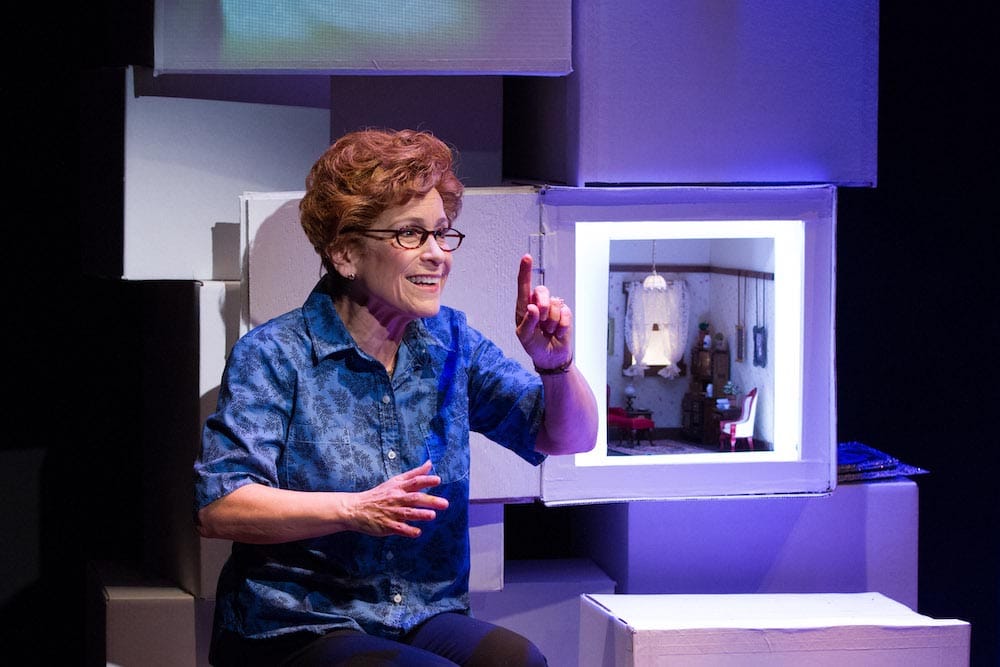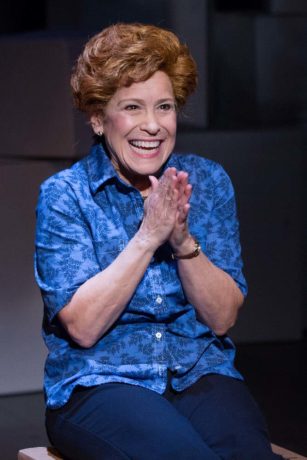The atmosphere at the opening night of Theater J’s remounted production of Becoming Dr. Ruth was “like water for chocolate”: simmering with anticipation. The audience was glad to be together again after 18 months of isolation occasioned by the nationwide lockdown to deter the spread of COVID. This isolation had come on top of our being rudely awakened to the fact that the faces of white supremacy (including antisemitism), authoritarianism, and fascism have once again become unashamed to be visible and to lay claim to becoming the standard for human interaction.
As I sat taking in the play, it seemed to me that this audience, this congregation (myself included), was hungry: for every syllable actor Naomi Jacobson spoke in Dr. Ruth’s melodic cadence, for every affirmative sentiment with which Dr. Ruth encourages us to embrace our experiences of joy, fear, and suffering and what we learned from them. This with which we are currently confronted is a world that Dr. Ruth survived once before. What comfort and guidance would the good Doctor give?

Dr. Ruth seizes upon many teachable moments throughout this play. Two stand out to me. At one point, she brings to our attention one obligation that Jews are called to fulfill and how it dovetails with her particular unlikely skillset:
In the Jewish tradition sex is not shameful. It’s a celebration of love. There is a phrase in Hebrew: Tikkun Olam. It means repairing the world. I never thought it would be through sex therapy but this is my way. It is my obligation. Since I have survived and 1,500,000 children did not.
And at another point, Dr. Ruth reminds us of a statement Hannah Arendt made:
“Education is the point at which we decide that we love the world enough to assume responsibility for it.” It is up to us — all of us together. Let us take responsibility.
We had our marching orders.
This one-person play by Mark St. Germain takes us through the life that Dr. Ruth lived from being a little Jewish girl named Karola Siegel escaping Nazi Germany, to becoming a Zionist sniper in Palestine. From being a kindergarten teacher in Paris to becoming a professor in New York, and finally evolving into the celebrity sex therapist we all know as Dr. Ruth. This is a woman who is filled with curiosity about the world and a determination to encourage the greatest curiosity in others.
All lives are precious, but there are usually only shades of difference as far as plot goes. Dr. Ruth’s life is engaging, but all one-person shows risk being boring. After all, there is only one person on stage and often one set. Had the production been staged in a naturalistic or realistic setting we would have been locked into the facts as they are recited to us and the world that we see concretized onstage. Naomi Jacobson, whose previously Helen Hayes Award–nominated portrayal of Dr. Ruth anchors us in and guides us through this production apparently had similar concerns (as she wrote in “Why I Agreed to Play Dr. Ruth” in the program that accompanies the show):
I had a few conditions. I didn’t want to do the play on a realistic set — I wanted the story to reflect an inward journey. I didn’t want to be confined to an imitation; it was more important for me to channel her essence.
This stipulation paid off spectacularly well in the evocative set and lighting.

The set consists of boxes. These are not the tan storage boxes we are used to seeing, prepped for pick-up by the movers. Rather, scenic designer Paige Hathaway has immersed Dr. Ruth in mountains of stark, white boxes, so many that they soften and obscure the outlines of the apartment Dr. Ruth is preparing to vacate. Each box contains a diorama — a miniature, three-dimensional representation of a time-and-psyche-curated, well-lighted, and well-maintained memory: literal representations of Dr. Ruth’s “inward journey.” The effect of seeing these boxes opened and animated is, by turns, delightful, dizzying, mesmerizing, tantalizing, and hunger-inducing: we want to see more. We want to see further and deeper into these tastily detailed and preserved memories. It’s not surprising that we laugh when, over the telephone, she alerts the movers to expect “a little clutter.” What an understatement.
The repeated opening of new dioramas throughout the evening encourages the audience to continue to engage with Dr. Ruth’s memories as well as to contemplate what might be contained in the dioramas our own lives.
Director Holly Twyford should be credited with guiding this collaboration to its memorably rewarding result.

Dr. Ruth, herself, has already been cited as declaring that Naomi Jacobson’s performance is “perfect.” Jacobson says that she sought to “channel” Dr. Ruth. And, indeed, Jacobson seems to live deftly and gently in Dr. Ruth’s skin. There is no feeling that anything in the performance is being forced or rushed. Jacobson’s performance is master class acting that, rather than intimidating us, welcomes us in.
The play itself is gentle and at times laugh-out-loud funny. The pain and the horrors that occur in the course of Dr. Ruth’s life are acknowledged — not dwelled upon but, like all grief and loss, lived with: engaged with. This play is something one is gratified to spend a couple of hours experiencing. It declines the proposal to stargaze at its subject. Instead, Germain’s script facilitates our getting to know Dr. Ruth in the service of our getting to know ourselves more and noticing what we have in common with her. James Baldwin often is quoted saying, “Our suffering connects us.” Becoming Dr. Ruth demonstrates how it connects us and reminds us of our capacity and obligation on account of that connection to try to heal the world.
Running time: 90 minutes without intermission
Becoming Dr. Ruth plays through October 24, 2021, at Theater J, in the Aaron and Cecile Goldman Theater, located inside the Edlavitch DC Jewish Community Center at 1529 16th St. NW, Washington, DC. Patrons will be able to buy tickets to see the play in person or stream the production from home. For tickets, call the box office at (202) 777-3210, or purchase them online. (The box office is available from 1 pm to 5 pm Monday through Friday and one hour before a performance.) Single ticket prices range from $35–$70. Discount ticket packages are available for three or more plays in Theater J’s 2021–2022 season, in addition to flex passes.
See Theater J’s Safety Guidelines.
CREDITS
Becoming Dr. Ruth by Mark St. Germain
Dr. Ruth K. Westheimer – Naomi Jacobson
Director – Holly Twyford
Scenic Designer – Paige Hathaway
Costume Designer – Robert Croghan
Lighting Designer – Colin K. Bills
Sound Designer – Kenny Neal
Projection Designer – Sarah Tundermann
Props Design – Mollie Singer
Projection Stage Manager – Madison Bahr
Wig Designer – Anne Nesmith
Assistant Stage Manager – Margaret Warner
Covid Safety Manager – Rebecca Talisman
SEE ALSO:
An interview with Dr. Ruth, whose story became ‘Becoming Dr. Ruth’ at Theater J by Ravelle Brickman
Theater J announces new season, life-affirming and in person
‘Becoming Dr. Ruth’ at Theater J review of the 2018 production by David Siegel





Wonderful!